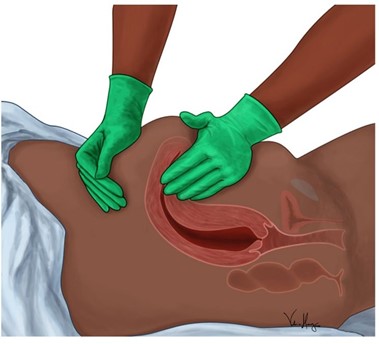On the first day after a cesarean section, a client who is a primipara is being assisted to the bathroom for the first time.
The client experiences a sudden gush of vaginal blood and notices that several blood clots are in the toilet. Which action should the practical nurse (PN) take?
Insert an indwelling catheter to empty the bladder and contract the fundus
Check fundal consistency and continue to monitor the lochial flow amount
Return the client to bed and maintain bedrest until the lochial flow slows
Massage the fundus and avoid direct pressure on the cesarean incision
The Correct Answer is D
The correct answer and explanation is:
d) Massage the fundus and avoid direct pressure on the cesarean incision.
This is the best action to take for a client who experiences a sudden gush of vaginal blood and clots after a
cesarean section. Massaging the fundus helps to stimulate uterine contractions and reduce bleeding.
Avoiding direct pressure on the incision prevents pain and wound dehiscence.
a) Insert an indwelling catheter to empty the bladder and contract the fundus.
This is not the first action to take for a client who experiences a sudden gush of vaginal blood and clots after a cesarean section. Inserting an indwelling catheter requires a physician's order and may cause discomfort and infection. The client may already have a catheter in place after the surgery.
b) Check fundal consistency and continue to monitor the lochial flow amount.
This is not enough to do for a client who experiences a sudden gush of vaginal blood and clots after a cesarean section. Checking fundal consistency and monitoring lochial flow are important, but they do not address the cause of bleeding or prevent further blood loss.
c) Return the client to bed and maintain bedrest until the lochial flow slows.
This is not appropriate for a client who experiences a sudden gush of vaginal blood and clots after a cesarean section. Returning the client to bed and maintaining bedrest may delay ambulation and increase the risk of thromboembolism. It also does not stop the bleeding or treat the underlying cause.

Nursing Test Bank
Naxlex Comprehensive Predictor Exams
Related Questions
Correct Answer is D
Explanation
-
Correct Answer is D
Explanation
Choice A rationale:
Sinus tachycardia may occur in response to various stressors or physiological conditions but is not directly related to anorexia nervosa or severe malnutrition. It is not the primary pathological process resulting from this condition.
Choice B rationale:
Menstrual cramps are not a pathological process but rather a symptom that may result from hormonal changes or other factors. While amenorrhea (absence of menstrual periods) is a common feature of anorexia nervosa, menstrual cramps are not a primary concern in this context.
Choice C rationale:
Hypertension is not typically associated with anorexia nervosa or severe malnutrition. In fact, individuals with anorexia nervosa often experience hypotension (low blood pressure) due to dehydration and nutritional deficiencies.
Choice D rationale:
Amenorrhea is the primary pathological process resulting from the adolescent's consistent maladaptive behavior of anorexia nervosa. Severe malnutrition and low body weight can disrupt the normal menstrual cycle and lead to amenorrhea. This is a significant concern for individuals with anorexia nervosa and can have long-term health implications.
Whether you are a student looking to ace your exams or a practicing nurse seeking to enhance your expertise , our nursing education contents will empower you with the confidence and competence to make a difference in the lives of patients and become a respected leader in the healthcare field.
Visit Naxlex, invest in your future and unlock endless possibilities with our unparalleled nursing education contents today
Report Wrong Answer on the Current Question
Do you disagree with the answer? If yes, what is your expected answer? Explain.
Kindly be descriptive with the issue you are facing.
